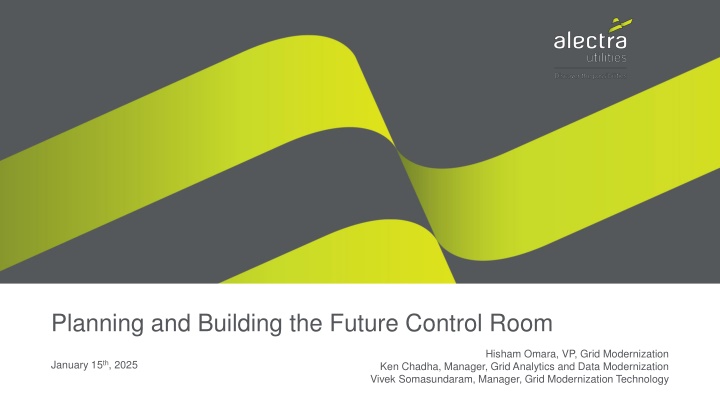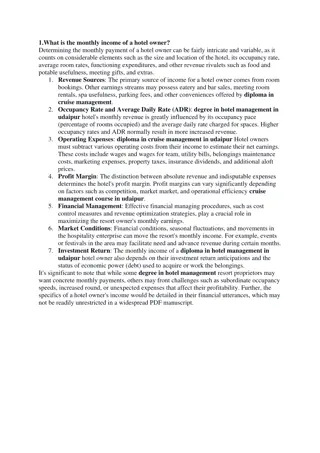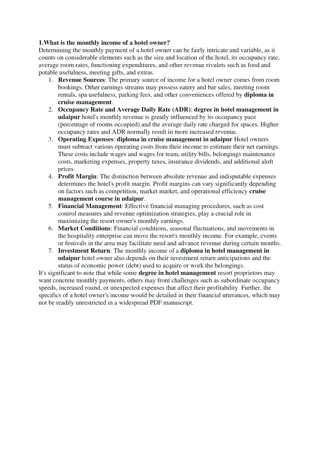
Building the Future Control Room for Grid Modernization - Alectra Inc.
"Discover how Alectra Inc. is addressing the challenges in Ontario's energy landscape by transforming outdated practices to predictive capabilities for grid modernization. Learn about the significant investments required and the shift toward intelligent decision-making amidst growing system complexity and electrification goals."
Download Presentation

Please find below an Image/Link to download the presentation.
The content on the website is provided AS IS for your information and personal use only. It may not be sold, licensed, or shared on other websites without obtaining consent from the author. If you encounter any issues during the download, it is possible that the publisher has removed the file from their server.
You are allowed to download the files provided on this website for personal or commercial use, subject to the condition that they are used lawfully. All files are the property of their respective owners.
The content on the website is provided AS IS for your information and personal use only. It may not be sold, licensed, or shared on other websites without obtaining consent from the author.
E N D
Presentation Transcript
Planning and Building the Future Control Room Hisham Omara, VP, Grid Modernization January 15th, 2025 Ken Chadha, Manager, Grid Analytics and Data Modernization Vivek Somasundaram, Manager, Grid Modernization Technology 1
DISCLAIMER The information in these materials is based on data currently available to Alectra Inc. and its affiliates (collectively referred to as Alectra ) and is provided solely for informational purposes. These materials are not intended to represent Alectra s official policies, strategies, or approaches and should not be interpreted as such. While Alectra strives to ensure the accuracy and reliability of the information provided, no guarantees are made regarding its completeness or timeliness. Alectra assumes no obligation to revise or update these materials. Alectra (including its directors, officers, employees, agents, and subcontractors) disclaims all liability for any reliance placed on this information or for any actions taken based on it. The content herein should not be considered a definitive guide or a substitute for professional advice tailored to specific circumstances. These materials may also contain statements about potential future developments or outcomes ( Forward-Looking Information ). Such information is provided for context and general insight and may not accurately reflect Alectra s future strategies or operations. Forward-Looking Information is subject to inherent uncertainties and risks, which could result in outcomes that differ materially from current expectations. This list of potential uncertainties includes, but is not limited to, changes in market conditions, regulatory landscapes, and operational dynamics. All information in these materials is qualified by these disclaimers. Alectra makes no commitment to update or modify the content based on new information, future events, or evolving circumstances, except as required by law. 2
ABOUT ALECTRA Alectra is an energy company that distributes electricity and provides innovative energy solutions to customers in the Greater Toronto and Hamilton area, with over C$4.8 billion in assets and 1,500 employees. Alectra Utilities serves over 1 million residential and commercial customers by distributing electricity; regulated by the Ontario Energy Board. Alectra Energy Solutions and Services provides innovative energy solutions, such as EV charging infrastructure, microgrids, energy storage, solar PV, metering, street lighting deployment services. 3
CHALLENGING LANDSCAPE (ONTARIO) Faced with increasing system complexity, the arrival of bi-directional grids, and a host of new players, it has become essential for utilities to move from out-of-date operating practices and manual processes to predictive capabilities and integrated, intelligent decision-making. The cost of grid reinforcement is estimated to be between $375 billion to $425 billion (Transmission and Generation Costs only) in new infrastructure investment by 2050 in Ontario just to meet load growth and electrification goals. Distribution utilities would be required to double or triple their system capacity to meet the electrification targets (Uncertainty on adoption timeframes) Customers Electrification of transportation and heating Increase 40% yoy in interconnection requests over the last 5 yrs Pressure to keep costs down ( cost living crisis ) 4
CHALLENGES FOR FUTURE CONTROL ROOM As the grid continues to modernize, several key challenges will require the implementation of an Advanced Distribution Management System (ADMS) and a future-ready control room. These challenges include: Operating Closer to the Limit: With increasing demand and Distributed Energy Resources (DERs) putting additional strain on the grid, operators will need to monitor and control the system more precisely. ADMS will provide the real-time data and automation required to safely operate closer to grid capacity limits without compromising reliability. DER Integration: The rise of DERs, such as rooftop solar, battery storage, and electric vehicles, introduces new complexities in balancing supply and demand. ADMS will play a crucial role in integrating these resources efficiently, enabling operators to manage variability and ensure seamless coordination between centralized and decentralized energy sources. Flexible Connections: As more customers seek flexible grid connections for their DERs, dynamic adjustments to accommodate varying supply and demand patterns will become essential. ADMS will allow for the management of these flexible connections, ensuring grid stability while optimizing resource utilization. Non-Wires Solutions (NWS) Operations: To defer traditional infrastructure investments, NWS will become more prevalent. ADMS will facilitate the integration and operation of NWS by optimizing grid performance through distributed resources rather than physical grid upgrades, making the grid more cost-effective and adaptable. Two-Way Power Flows: The grid is transitioning from a one-way power flow system to a two-way flow due to DERs feeding electricity back into the grid. ADMS will be essential in managing these bi-directional power flows, ensuring stability, proper voltage management, and coordination of protection systems. 5
PREREQUISITES TO ADMS/FUTURE CONTROL ROOM Key to any ADMS or future control room engagement is to address several key prerequisites Data Data Quality: Ensure accurate, complete, and up-to-date data to feed into the ADMS for effective decision- making. This includes asset data, network models, and operational data. Data Standardization: Develop and adhere to data standards to facilitate seamless integration between existing systems like SCADA, GIS, OMS, and DERMS Data Governance: Establish policies for data ownership, security, and privacy to maintain the integrity and reliability of data assets. Architecture System Architecture: Define a scalable and modular architecture that supports current needs and future growth Interoperability: Ensure the architecture supports open protocols and standards to enable seamless communication between legacy systems and new ADMS components. Cloud and Edge Integration: Explore opportunities to leverage cloud-based analytics and edge computing 6 for enhanced processing and scalability
PREREQUISITES TO ADMS Process Define and documentation existing processes and future processes Control Strategy Centralized vs. Decentralized Control: Define the control philosophy that best suits your operational model, balancing centralized decision-making with decentralized execution for flexibility. 7
WHY FOCUS ON DATA AND ANALYTICS To effectively implement an Advanced Distribution Management Systems (ADMS) or any system it is critical to have standardized, interconnected, clean, and reliable distribution system data. Ignoring data quality issues results in escalated costs for an ADMS implementation one utility incurring an additional $5 million and prolonged deployment timelines. Post-deployment, there is a risk of operators disabling features due to distrust in the data provided. 10
OUTCOMES OF PROPER DATA QUALITY AND GOVERNANCE Accurate Grid Operations High-quality data ensures reliable grid models, better load forecasting, and precise fault detection. Improved Visibility Real-time data enhances grid monitoring, enabling faster issue detection and resolution. Optimized Performance Data drives automation, enables the enhanced operation of the distribution system, and improves overall grid efficiency. 11
KEY RISKS OF POOR DATA QUALITY AND GOVERNANCE Inaccurate Grid Modeling Misaligned or outdated geospatial data leads to incorrect system topology, causing inefficiencies in power flow and load management. Faulty Outage Management Errors in geospatial data hinder precise fault location and slow down restoration efforts, increasing customer downtime. Compromised Safety Incorrect asset locations or connectivity can endanger field crews, causing safety risks during repairs or maintenance. This will lead to a lack of trust in the system. Ineffective Automation Automated processes like switching and voltage regulation fail without accurate geospatial data, reducing system reliability and efficiency.5. Regulatory Reporting Challenges 12
WHAT IS INTEGRATED NETWORK MANAGEMENT (INM) INM is a centralized and unified representation of the distribution system, combining data from various systems such as (not inclusive): GIS (Geographic Information System) for asset locations and connectivity SCADA (Supervisory Control and Data Acquisition) for historical operational data OMS (Outage Management System) for historical fault and outage information Key Features of INM: Unified Data Source: Consolidates and synchronizes data across planning, operations, and analytics tools. Accurate Grid Representation: Provides a holistic and precise model of the grid for better decision-making. Automated Data Validation and Correction: Ensures data quality and reduces errors. Interoperability: Uses standardized formats that can be leveraged by multiple systems like ADMS, planning tools, and reporting platforms. 13
KEY BENEFITS FOR THE CONTROL ROOM Accurate Network Representation INM consolidates data from various sources to provide a unified and accurate grid model, enhancing ADMS performance. Improved Data Quality and Consistency Ensures clean, validated, and synchronized data across systems, reducing errors and discrepancies in grid operations. Enhanced Geospatial Precision Provides precise asset locations and connectivity, enabling better outage management, fault detection, and crew deployment. Streamlined Integration Facilitates seamless data exchange between systems reducing deployment time and complexity. INM would be the source of truth for network/connectivity models that have been vetted by system planners. Supports Advanced ADMS Features Enables key ADMS functionalities like load forecasting, real-time grid monitoring, and automated switching with higher accuracy. Improved Decision-Making Provides power system controllers with a holistic, data-driven view of the grid, supporting proactive management and faster issue resolution without overburdening them with excess information 15
ADMS/FUTURE CONTROL ROOM FUNCTIONS Integrated System Architecture: ADMS combines SCADA, OMS, and Distribution Management System (DMS) functionalities into a single, integrated platform. This integration streamlines operations and reduces the complexities associated with managing multiple, disparate systems. 1. Real-Time Operational Efficiency: ADMS will enable the grid to operate closer to its limits dynamically and safely. 7. Operationalization of Non-wires Solutions: ADMS would enable the real time operations of NWSs to not only defer capital but also for real time operational needs such as voltage management, reduction in outage and system restoration. 8. Enhanced Grid Reliability and Efficiency: ADMS provides more advanced tools for monitoring and controlling the distribution grid. This leads to improved grid reliability and operational efficiency, as ADMS can more effectively manage outages, balance loads, and integrate renewable energy sources. 2. Centralized and Decentralized Control: ADMS offers a blend of centralized and decentralized control, allowing utilities to manage large-scale grid operations from a central location while also giving local control centers or field devices autonomy to make decisions. This dual approach enhances grid responsiveness and flexibility, enabling faster reaction to local grid conditions while maintaining overall system integrity and coordination. 9. Improved Situational Awareness: With ADMS, operators have a comprehensive view of the grid's status in real-time, including detailed insights into grid conditions (telemetry, state estimation analytics, etc ). This enhanced visibility supports better decision-making and faster response to grid disturbances. 3. Autonomous Control (Co-Pilot Functionality): ADMS can function as a 'co-pilot', providing autonomous control where the system makes decisions based on pre-set criteria and real-time data. This includes automatic reconfiguration of the network in response to outages or load changes. Such autonomy is crucial for handling complex grid scenarios efficiently, reducing manual workload, and improving operational accuracy. 10. Advanced Analytics and Forecasting: ADMS platforms often include advanced analytics capabilities, enabling utilities to perform more sophisticated data analysis for predictive maintenance, load forecasting, and more proactive grid management. 4. Increased Scalability and Flexibility: As grid requirements evolve, ADMS's scalable and flexible architecture allows utilities to adapt to new challenges and technologies, ensuring the grid remains future-proof. 5. Scenario Planning: ADMS enables operators to run various "what-if" scenarios, assessing potential impacts of different situations like equipment failure, demand surges, or integration of renewable energy sources. This capability allows for proactive planning and better preparedness for various operational challenges, enhancing grid reliability. 11. Enhanced Autonomous Control: ADMS offers sophisticated automation capabilities that allow for autonomous control of the grid. It uses real-time data and predictive analytics to make decisions without human intervention, improving response times to grid disturbances. 6. Disaster/Storm Management: In the event of a disaster or severe weather, ADMS provides critical support in managing the grid. It helps in quick identification of affected areas, prioritizes restoration efforts, and efficiently reroutes power. The system can also predict the potential impact of incoming storms or disasters on the grid, allowing for preemptive actions to mitigate damage. 12. 17
FOCUS ON FUNCTION, NOT TECHNOLOGY Utility-led Requirements Definition Education: Ensure all relevant teams (Control Room, SCADA, Telecom, IT, Metering, etc.) are well-versed in ADMS functionalities and benefits. Sector Engagement Vendor Engagement Define Current and Future Roadmap: Establish current needs and future requirements. (functionality NOT TECHNOLOGY) and delivery timelines. Detailed functional requirements and non functional requirements User journeys and use cases Future proofed Architecture and Integration Create a platform approach: Develop an approach where you can incorporate additional features, self develop capabilities, and engage with the best of breeds Evaluation Criteria: Identify and document key performance metrics, stakeholder requirements, and system capabilities to guide vendor selection and system design Engagement: Staff engagement and end user engage (engage everyone who touches the tool or is impacted by it) 18
FUNCTION, NOT TECHNOLOGY Phased/Agile Approach Phased Rollout: Begin with pilot implementations in select regions or functionalities to minimize risks and gather learnings. Exit Ramps: Build exit strategies for each phase to reassess feasibility, costs, and performance before scaling. Change Management Develop a structured change management plan to address organizational and technical transitions. (Process, data, etc.) Adequately stakeholder engagement, build adequate time to enable the change management prior to procurement Incorporate the change management in any future procurement documentation 19
FUTURE CONTROL ROOM APPROACH 1) Organizational Buy-in, Education and Engagement a)Exciting time: Organizational transformation (People, Processes, Platforms), not just a technology adoption b)Key Stakeholders: Control Room, Control Room Supervisors, Engineering, Operations IT 2) Use Cases and User Journeys a)Capture Existing Processes and Tools b)Improve existing use cases and user journeys c) Identify new use cases and user journeys d)Identify Interactions, Systems Responses, Decision Making Processes for each use case e)Validate with Key Stakeholders 3) Requirements Gathering Processes to capture organizational needs a)Identify Goals and capture needs of organization b)Value Capture (time saved or new functionality) to quantify benefits c) Draft requirements and validate with stakeholders d)Engage Enterprise Architecture team to understand current and future requirements 20
SET THE STAGE (ITERATIVE PROCESS) INPUT ASSESSMENT RESULTS ANALYSIS Departments / Teams Data Flows Operations IT Customer Service Capital Planning Metering Finance Meetings TMO Regulatory Requirements, Use Cases and User Journeys Team Meetings SME Meetings (50 100) Meetings PEOPLE Team Meetings SME Shadowing Workshops Meetings PROCESS Shadowing Workshops TECHNOLOGY Documents Samples of inputs Procedures Workflows Reports 21
Thank you! Hisham Omara, VP, Grid Modernization Ken Chadha, Grid Analytics and Data Modernization Vivek Somasundaram, Manager, Grid Modernization Technology 22






















